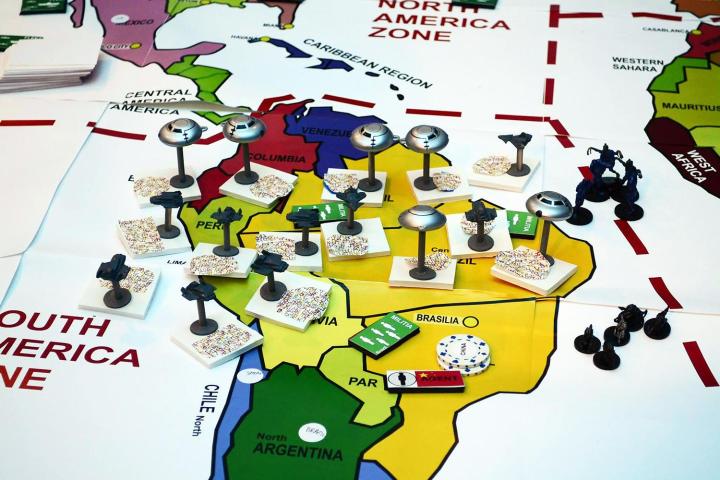
“The aliens have landed in Mexico.”
Watch the Skies was originally designed and played by the British group Megagame Makers, who have been organizing these massive simulations since the early 1980s. Just as Dungeons & Dragons (and by extension all modern RPGs) did before them, megagames sprang directly from that classic ur-hobby of alpha nerds: wargaming. Their subject matter ranges from fantasy pirates and space empires to feudal Japan and World War I. The events bear some resemblance to LARPing, but infused with board game mechanics and a rigid turn structure.
Megagames caught the attention of American gamers earlier this year when the popular British board game site Shut Up & Sit Down played Watch the Skies in London and posted a video of the event. Noam Strassfeld and Shyamal Ruparel, New York City residents and avid gamers, immediately recognized how much interest a game like that could generate stateside and contacted Megagame Makers about organizing the first American instance of a megagame. Their assessment was correct, since the game sold out within two hours of a SU&SD news bump, leaving a whole second game’s worth of people on the wait list.
The action was set in the near future of 2020. Teams of four or five people represented the nations of France, Russia, India, Japan, Brazil, UK, China, and the USA. Their starting resources were roughly proportional to what those countries have now, so as the United States, my team began with the largest economy and military. Our plan going in was to leverage that early advantage into becoming the best-equipped and most technologically advanced strike force for dealing with alien threats around the world–we wanted to be XCOM.
Brazil and eventually China sold out their people to the aliens, sending them up by the shipload for “healing.”
Each of these sub-games was partitioned: only military heads were allowed in the map room, only diplomats in the UN, etc., meaning that planning and communication were of the utmost importance. As one of the larger nations of the world, we were fortunate enough to have a fifth team member playing as Vice President, who could freely roam between all of the areas and ensure that we were on the same page. My role as President was to coordinate their efforts, negotiate with other heads of state, and distribute the fixed number of Resource Points (represented by poker chips) that we were allotted every turn based on the state of our public opinion.
Turns lasted a (theoretically) strict half hour each, with fifteen minutes for the teams to plan and then splitting off into their respective games for fifteen minutes of execution. In practice the turn structure fell a bit off kilter as the game went on, but no more than you might expect from the first time executing such a massive undertaking, and plans have already been made to rectify it for future instances.
The crunch of time and resources, combined with the limited flow of information, created a marvelous tension that made every minute of the nine-hour game feel important. Rather than playing through a predetermined story, the game’s structure allowed for dozens of individual decisions to add up into an emergent and surprising narrative in which we all had a stake.
First Brazil and eventually China sold out their people to the aliens, sending them up by the shipload for “healing,” which actually meant that those unlucky souls were reprogrammed through a neurovirus to be less aggressive. The Reticulans, our aliens du jour, claimed that they came to Earth in ancient times to modulate our primitive minds (perhaps with sheer, black monoliths), but on returning they became concerned that our aggression had grown out of control, and that we were poised to spread chaos throughout the galaxy once we became a spacefaring civilization.
As a display of peaceful intentions once the alien motivation was made clear, most of the major nations with nuclear capabilities disarmed themselves, but Russia refused to go down quietly. In a dramatic final turn (captured on video) the entire alien fleet landed in Brazil. Russia launched their whole nuclear arsenal in response. Brazil, however, had already sent an agent into Russia who tampered with their warheads, causing the nukes to explode in their tubes and wipe Russia off the map. Immediately afterward a ship full of world leaders was sent up to the Mars base for peace negotiations and “healing.”
While that finale was certainly exciting, it did bring to light one of the megagame’s major structural flaws as currently designed: the game’s end was arbitrarily dictated, with no internal reason for it to conclude when it did. Russia’s rash actions seemed largely driven by a desire to see something exciting happen at the end, and had the game continued for a few more turns the results could have been very different. While many teams apparently perceived the game’s resolution as a success for humanity, we Americans were deeply uncomfortable with its implications. Spreading viruses to reprogram humanity into docility was itself a horrific and invasive act of aggression, undermining any moral high ground the Reticulans claimed as an “enlightened” species. The U.S. team had also made a show of publicly disarming our nuclear arsenal along with the other nations, but had actually undertaken a mission to hide our weapons in a secret location, ready for when we needed them. Through our aggressive research program we had managed to find the location of the main alien base on Mars and built a ship that could get us there with our cybernetically-enhanced soldiers and nuclear weapons—had the game gone on, the United States was prepared to defend the sovereignty of our minds with deadly force.
In a dramatic final turn, the entire alien fleet landed in Brazil.
It’s a high that we will all be chasing again. There was the buzzing energy of a newly formed community at the bar everyone headed to afterward, where people shared contact information for smaller game nights and eagerly discussed when we could do it again. Based on the glowing reviews of everyone who took part and the extensive list of people that were not able, NYC Megagamers will run Watch the Skies again in December with a different alien scenario (so no need to worry about spoilers). Afterward, they will look into both adapting more of the British group’s existing megagames and creating originals. If you are interested in updates on upcoming games, you can follow NYC Megagamers on Facebook and Twitter.





